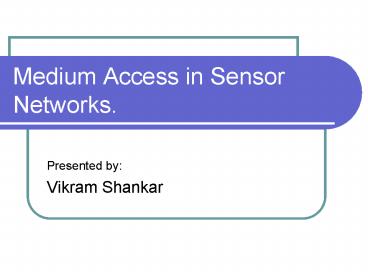Medium Access in Sensor Networks. PowerPoint PPT Presentation
1 / 15
Title: Medium Access in Sensor Networks.
1
Medium Access in Sensor Networks.
- Presented by
- Vikram Shankar
2
Objective
- What is a MAC? Why is it needed?
- Study effect of MAC design on performance.
- Performance in terms of
- Energy Efficiency
- Fair bandwidth allocation
- Throughput Efficiency
- All graphs and data are from 1.
- S-MAC is discussed in 2.
3
Medium Access Control
- Coordinates medium access in the presence of
multiple stations. - Part of the Data Link Layer in ISO OSI protocol
stack. - May also perform local error recovery.
4
Characteristics of Sensor Networks
- Low energy availability.
- Limited transceiver capability
- Half duplex
- No collision detection
- Few bits of buffering
- Sporadic bursts of correlated data.
- Short data packet length.
- Roughly same cost for transmitting, receiving and
listening. - Hidden terminal problem between every other pair
of levels in network topology.
5
Hidden and Exposed Terminal Problems
Hidden Terminal
Node Yellow
Node Red
- Node Green
Node Blue
Exposed Terminal
Node Yellow
Node Red
Node Green
Node Blue
6
Sources of Energy Wastage
- Packet collisions
- Overhearing
- Idle listening (consumes 50100 of the energy
required for receiving) - Control Packet Overhead
7
MAC Design
- Available design choices 1
- Listening mechanism.
- Random time
- Constant time
- Backoff mechanism.
- Fixed window.
- Exponential increasing window.
- Exponential reducing window.
- Contention based mechanism.
- RTS/CTS
- Rate control mechanism.
8
Design
CSMA Schemes (DelayListenBackoff) Random Delay Listening Time Backoff Mechanism
ND_RAND No Random None
ND_RAND_FIX No Random Fixed Window
ND_RAND_EXP No Random Exp Increase
ND_RAND_REVEXP No Random Exp Decrease
ND_CONST_FIX No Constant Fixed Window
ND_CONST_EXP No Constant Exp Increase
ND_CONST_REVEXP No Constant Exp Decrease
D_CONST_FIX Yes Constant Fixed Window
D_CONST_EXP Yes Constant Exp Increase
D_CONST_REVEXP Yes Constant Exp Decrease
9
Throughput Efficiency
- Offered load of 5 packets/second/node with
slightly different start times. - Channel capacity is 20.8 packets per second.
- Schemes with constant listen period and no
random delay (ND_CONST_???) achieve highest
bandwidth. - ND_CONST_??? Schemes are unstable because of
repeated collisions. - As load exceeds capacity, all schemes except
802.11 achieve 75 efficiency.
10
Throughput Efficiency (Worst case scenario).
All nodes are synchronized to start at the same
time.
In the absence of collision detection hardware,
random backoff not sufficient to avoid repeated
collision. Why? ACK failure in 802.11 triggers
retransmissions. ND_CONST_??? schemes have zero
bandwidth utilization.
11
Lessons of Throughput Study
- Backoff mechanism has no effect on performance.
- Even ND_RAND, which has no backoff mechanism
performs as well as others. - Randomness in pre-collision phase is essential
for robustness.
12
Energy Consumption
- 802.11 has worst performance because it listens
even during backoff. Becomes worse when we
account for ACK overhead. - Schemes with constant listen period most energy
efficient (10µJ/packet). - Schemes with random listen period consume
40µJ/packet. - Delay has no effect on energy as transceiver is
turned off.
13
Fairness of CSMA Schemes
Three schemes are very similar. Standard
deviation of approximately 0.25 packets/sec and
decrease with increase in traffic. Thus, backoff
mechanism has no effect on fairness at uniform
load.
14
Fairness with non-uniform load.
Data normalized to bandwidth of node 10.
- This time, backoff mechanism does have an effect
on fairness. - Binary exponential increasing backoff has worst
performance.
15
References
- 1 Alec Woo and David E. Culler, A Transmission
Control Scheme for Media Access in Sensor
Networks, Mobicom 2001, July 2001, Rome. - 2 Wei Ye, John Heidemann, Deborah Estrin , An
Energy-Efficient MAC Protocol for Wireless Sensor
Networks, INFOCOM 2002, New York, June, 2002.

